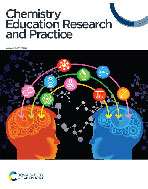Comparing drawing tasks and elaborate single-choice questions in simulation-based learning: how do they facilitate students’ conceptual understanding on chemical equilibria?†
Abstract
Past research repeatedly revealed students’ struggles to understand chemical equilibria, especially concerning their dynamic nature. Black-box simulations have proven to be helpful here. However, the effect is strongly dependent on the quality of teaching, the design principles of which are not yet fully known. One aspect of debate concerns the nature of supportive learning tasks, which require students to activate, construct and reflect on their mental models to foster conceptual understanding. In this paper, we investigate how drawing-assisted simulation-based learning promotes conceptual understanding of chemical equilibria in comparison to single-choice tasks. Both types of supporting tasks involve simulation-based activities according to the German instructional design SIMMS (Simulation-based Instruction for Mental Modelling in School), which requires students to construct their own explanations and predictions on a chemical system before exploring it via molecular dynamics simulations and revising their explanations and predictions retrospectively. In a quasi-experimental intervention study with 174 German high school students of ten chemistry courses (tenth grade), two treatment groups (drawing group and single-choice group) were compared with a control group, assessing the progress in conceptual understanding during simulation-based learning via drawings and explanations as well as pre- and post-intervention via questionnaire. Our findings reveal similar effects of drawing tasks and elaborate single-choice tasks on conceptual understanding of chemical equilibria. For equilibrium dynamics specifically, simulation-based settings featuring drawing tasks seem to be slightly more effective than simulation-based settings featuring elaborate single-choice-tasks in fostering understanding. What is more, simulation-based settings on the divergent phenomenon of Le Chatelier (where different final states emerge from the same initial state, depending on the nature of external perturbation) seem to be more efficient than those on the convergent nature of chemical equilibria (where several initial states with different educt/product ratios yield the same final state in equilibrium) in fostering student understanding irrespective of the mode of the supportive learning task.


 Please wait while we load your content...
Please wait while we load your content...